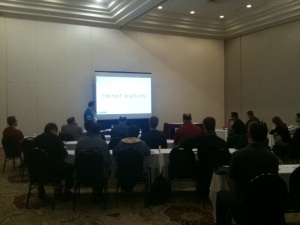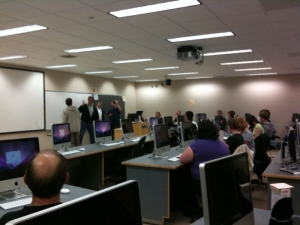It is impressive the number of people from big name companies that are not just giving talks but that make up the list of attendees. From reading attendees’ conference tags the company names I saw most often were Google, Yahoo, Boeing, IBM, Microsoft, Nortel Networks, and Sun Microsystems just to name a few. It was unusual to see a company name I didn’t recognize.
Each talk we attended today provided a wealth of excellent information. The following is a very brief overview of the talks.
To Catch a Bug You Have to Think Like a Bug
This talk was given by a developer from Google who previously worked for years on the JBuilder IDE tool. He gave a talk on how to trap bugs in code and surround them with targeted meaningful tests. This was more a tutorial than a lecture so he had us all fire up Eclipse and write test cases in JUnit to test methods in his example application. Much of the session was on not just writing tests, but figuring out what tests need to be in place to cover a method, but the catch was to do it in the least amount of tests possible. It was interesting, at the start of the session we were all coming up with much higher numbers of test cases, such as 8 to test a method, when he was able to show us how to get basically the same coverage in just 2 tests. It was a very helpful exercise. The end of the talk focused on refactoring existing code for testability.
Several books that came highly recommended were:
Code Quality – Diomidis Spinellis
Code Complete – by Steve McConnell
Is Agile Working for You
The lunch time keynote address was by Scott Ambler who is the Agile Practice Leader for IBM. His talk focused on issues with putting into place Agile development practices. The part of his talk I really enjoyed was about database testing. He mentioned how it is so common for the focus in unit testing to focus so heavily on application code, that the development of test cases that test the database without the application present are often ignored such as tests to test stored procedures, triggers, etc. He also stressed the value of writing a suite of database data integrity tests that can be run on a regular basis to check existing production data for problems.
Patterns of Refactoring
This talk was given by Joshua Kerievsky who is the author of the book with the same name. It was a live coding demo where he took us step by step though each of his refactoring patterns. Also he showed us many simple tactics he uses for doing refactoring in small simple steps to reduce the risk of making refactoring changes. Some of his refactoring patterns such as Gradual Cutover, Parallel Change, Inline Refactoring, and Narrowed Change I have used in the past, however the valuable part of this task was really in seeing the steps to implementing each of these patterns in a safe way. As he stressed the number one mistake made in refactoring is in trying to change too much too fast. Spreading it out in a series of steps is much safer and also an easier sell as it allows new development to be done in parallel with refactoring work.
For all of the live coding demos the presenter used Eclipse with both Java and C++ code samples. However, he did talk briefly about C# and highly recommended ReSharper.
Beautiful Code
The keynote address in the evening was a Q & A session with 6 of the authors of the “Beautiful Code” book. They discussed the basics of what makes beautiful code (Readability, Consistency, Simplicity, etc.) Later on they got into a discussion about languages themselves that they considered beautiful. Python was the main topic of the conversation.
That’s just a very brief overview of the talks, barely scratches the surface. It was an interesting first day.


 Marcos and I attended the
Marcos and I attended the 